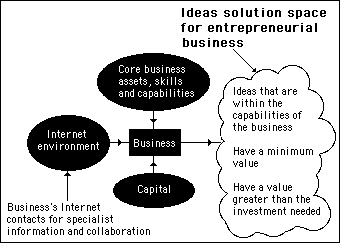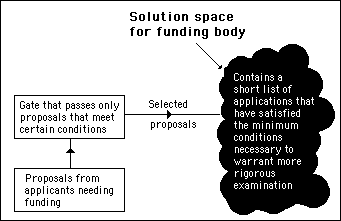
Chapter 2
At odds with the conventional world
Entrepreneurial businesses
Businesses created by entrepreneurs have to be generated from business ideas that come from within a solution space the entrepreneurs create for themselves: a short list of ideas that match the resources available to the entrepreneur. To be worth pursuing, these ideas must have a realistic chance of creating and maintaining a profitable income even if the intention of the entrepreneur is to make a capital gain.
It is common to think of these ideas as arising through an entrepreneur's imagination or from the shrewd reading of a market's needs. These will certainly be factors in the creation of an e-business, but, the most dominant influences will be the ability to put ideas into practice and the capital investment needed.
As soon as investments come into the picture it becomes pertinent to start thinking about the returns that would be expected by the investors who make these investments. This puts the spotlight on the financial gains that an idea might be expected to produce. In other words, ideas will have to be given a value to determine whether or not they will justify the amount of investment needed to turn them into reality. This should be the overriding consideration in determining whether or not an idea is allowed into an entrepreneur's solution space.
Obviously, the value of any idea in the solution space would have to be greater than the amount of capital needed to finance it. Additionally, the activity of putting the idea into effect will carry a minimum overhead – due to the running costs – which will set a minimum value for any of the ideas that can go through the gate. This scenario is illustrated in figure 2.3.

Figure 2.3
The ideas within an entrepreneurial business's solution space are limited to those that the business is capable of carrying out – and by the value of the idea in relation to the investment needed to put it into operation
From this view point, the boundary conditions of the business idea solution space can be defined as:
1) The idea must be within the capabilities of the business
2) The value of the idea must be greater than the amount of capital needed to finance it
3) The idea must have a minimum value determined by the running costs of the core business (or the running costs of a section of a large business if the idea is assigned as a project).
What is not always obvious is that a similar model is used by funding bodies. They will also have a solution space where they have gates designed to let suitable application proposals in and keep unsuitable application proposals out. However, most funding bodies will have traditional attitudes towards funding and their solution space will almost certainly be static and top down. This is illustrated in figure 2.4.

Figure 2.4
Funding bodies have a static, top down solution space that contains only proposals that meet certain criteria. It is only these that are given serious consideration
Funding bodies will not want to waste their resources on investigating every proposal that comes along (most funding bodies receive forty or fifty times as many proposals as their analysts can handle), so, they use a series of tests that eliminate all but the most promising. It is the funding body's skills in constructing such tests that determine the success or otherwise of their own business strategy.
Any sensible applicant for funding will make sure they know what tests are being made on the proposals they submit to a funding body to ensure that their proposal get through the gates. This raises a number of important questions:
1) What are the tests that funding bodies apply to proposals?
2) What if the tests are not compatible with the proposer's business strategy
3) What if the funding body's tests are wrong, such that the most promising business proposals are excluded and the least promising included?
To answer these questions, we'll need to know some of the technicalities involved in financial and investment valuations.